New World icons join top Tuscan wines for the first week of releases
A trading system used to distribute Bordeaux wines for almost 800 years, the Place de Bordeaux has, in more recent years, provided an international stage for many wines originating beyond its own borders. The first non-Bordeaux bottle to join La Place in 1998 was Almaviva, followed by Opus One in 2004, Masseto in 2008, and Solaia in 2009. Over the past decade, a further flurry of eminent estates from around the world have joined the distribution network, and together they form a campaign of new vintage releases every September.
 Seña and Chadwick owner, Eduardo Chadwick, and daughter, Magui
Seña and Chadwick owner, Eduardo Chadwick, and daughter, Magui
Which fine wines were released through the Place de Bordeaux this week?
South American superstars
Clos Apalta 2018 kicked off this year’s campaign on Tuesday 31st August, at £71.50 per bottle (in-bond). At this year’s CVBG London tasting at Berry Bros. & Rudd, Wine Lister enjoyed the elegance of the latest release, which boasted red fruits, pepper, and a hint of smokiness on the nose, and a fresh acidity and energy on the palate. Another vintage that adheres to the estate’s impressive quality consistency over the past five years, demand for the 2018 is further encouraged by Clos Apalta’s status as one of Chile’s leading wine brands.
Across the Andes, Catena Zapata released its 2018 vintage on Wednesday 1st September, with Nicolàs Catena Zapata entering the market at £53 per bottle (in-bond). Having gained 96 points from Joaquín Hidalgo for Wine Lister partner critic Vinous.com, the latest vintage achieves its highest ever-score from the critic outfit. He calls it “breathtaking”, with “layers of aroma, beginning with black currant and moving on to intense, precise notes of lavender and mint along with hints of black tea, sage and cigar box”.
Released yesterday (Thursday 2nd September) at £80 per bottle (in-bond), Seña 2019 was the product of a “long, stable ripening season”, according to owner, Eduardo Chadwick. Tasting with Wine Lister on Zoom, he explains that while “January did begin warmer than usual, summer in March was cooler than normal”, retaining freshness. Indeed, our team found the 2019 to be beautifully balanced, perfumed with muddled berries, sweet spice, and promising complexity of cherries and rustic earth, with satin tannins, on the palate. Supplemented by its high quality, the special-edition 25th-anniversary bottling should stimulate interest in Seña’s latest offering.
Describing Viñedo Chadwick 2019 as “one of the best recent vintages”, Eduardo tells us that, as ever, the character of the wine is shaped by the estate’s altitude. He explains that the great diurnal range throughout the warm growing season allowed freshness, encouraging what Wine Lister found to be both remarkable lift and flavour intensity, with aromas of iris, fresh herbs, and blackberry. Released onto the market at c.£230 per bottle, the 2019 was awarded 99 points by James Suckling, who echoes the sentiment that the wine is “refined, yet powerful”.
South African sweetness
On Wednesday 1st September, Klein Constantia released its Vin de Constance 2018 at £41 per bottle (in-bond). Wine Lister tasted the latest release on Zoom alongside Winemaker, Matt Day, and found notes of citrus and stone fruits complemented with notes of ginger on the nose, complete with a generous and balanced palate with a lightness and freshness that defies the stereotypes of “sweet wine”. Matt told us he believes the vintage represents an embodiment of his “fine-tuned” craft, which also coincided with “a perfect [growing] season”, encouraging the continuation of its positive quality trajectory this year. Indeed, the latest release (as yet not scored by any Wine Lister partner critics) gains 98 points from James Suckling in his most recent tasting.
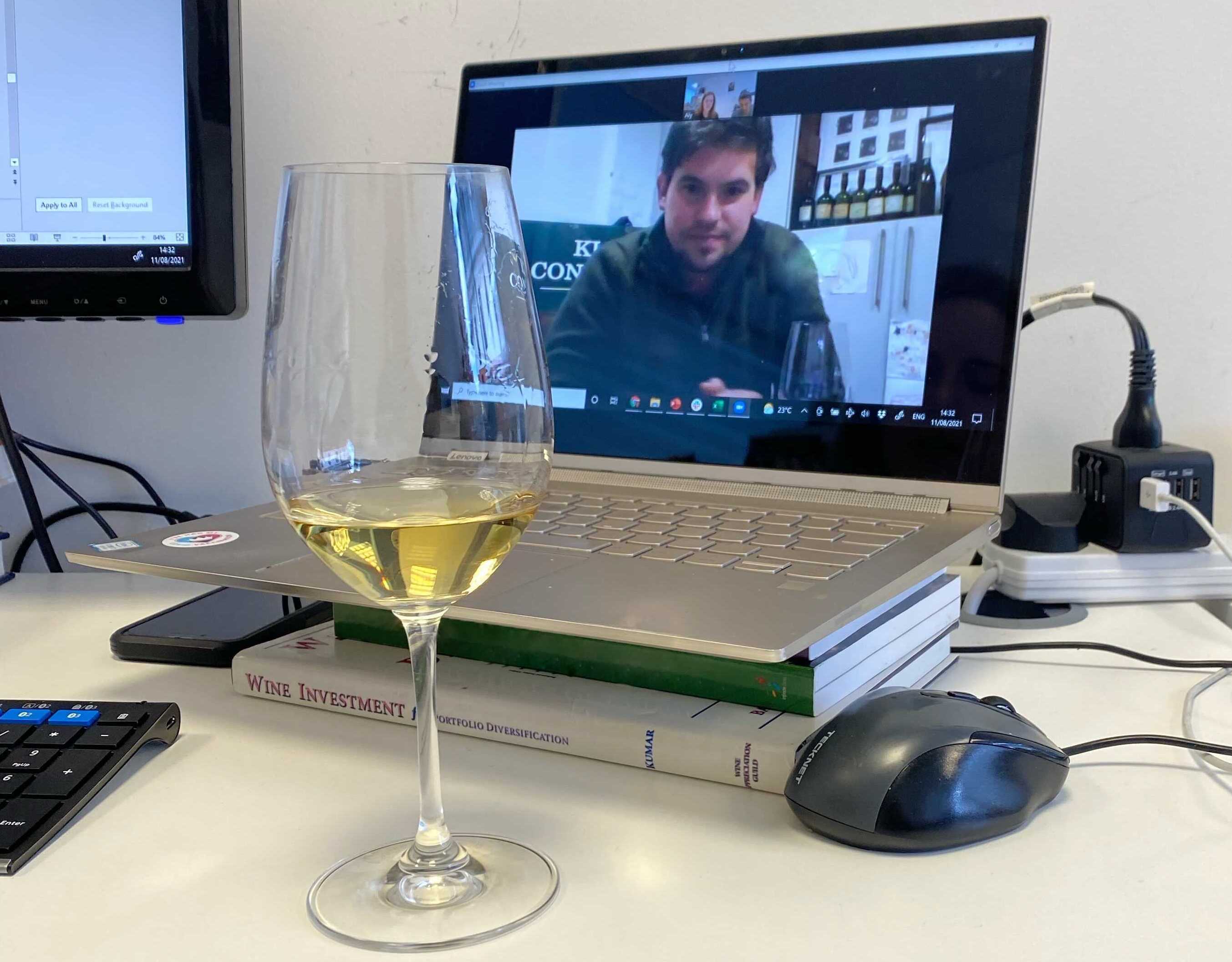 Tasting Vin de Constance 2018 alongside Klein Constantia Winemaker, Matt Day
Tasting Vin de Constance 2018 alongside Klein Constantia Winemaker, Matt Day
Top Tuscan offerings
Bibi Graetz’s Testamatta and Colore 2019 entered the market yesterday (Thursday 2nd September), at £73 and £180 per bottle (in-bond), respectively. Marking its 20th anniversary vintage, both wines feature special-edition bottles designed by artist turned vigneron, Bibi Graetz, with colour and text applied directly onto the glass. Wine Lister was particularly impressed with Colore 2019, which boasted a perfumed nose of violets, frangipane, and crushed berries, following through to a vibrant and juicy palate with silky tannins.
Wines likely to be released through the Place de Bordeaux next week include: Opus One 2018, Overture NV, Masseto 2018, Massetino 2019, Latour 2005, Almaviva 2019, Epu 2019, Cheval des Andes 2018, Solaia 2018, and Beaucastel Hommage à Jacques Perrin 2019.
Wine Lister speaks to 10 top sommeliers to find out more about their bottles of choice
 From left to right: Lupo Theones, Victor Petiot, Gareth Ferreira, Beatrice Bessi, and Paul Lo
From left to right: Lupo Theones, Victor Petiot, Gareth Ferreira, Beatrice Bessi, and Paul Lo
What top wines do sommeliers recommend?
Whether offering the perfect food pairing or serving an unforgettable glass, sommeliers are often responsible for creating moments of vinous magic shared by wine lovers far and wide. Our latest blog flips the script, with some of the world’s leading sommeliers sharing with us their most memorable pours, providing the ultimate guide on how to drink like a pro.
Read our blog on your favourite winemakers’ favourite wine for more insight into what the experts are drinking here.
Lupo Theones – Head Sommelier at Hélène Darroze at The Connaught, London
Lupo Theones shares the same sentiment as many of his peers: “it is challenging to choose a single wine when you taste so many great wines as a sommelier”. He nonetheless mentions Egon Müller’s Scharzhofberger Riesling Kabinett 2011 as a wine that “deeply impressed” him, having tasted it soon after moving to London to join The Connaught. Describing a “perfectly balanced” palate that “shows a great acidity and minerality”, Lupo notes that it is a wine you can drink on its own, or paired with the likes of sushi and shellfish, as well as Foie Gras.
Victor Petiot – Wine Director at Caprice at Four Seasons, Hong Kong
Having discovered the vintage just last year, Victor Petiot cites Toro Albalá Don PX 1931 as his favourite wine, due to its “uniqueness” after sleeping in barrel for over 90 years. He explains that it provides “the perfect balance between powerful and well-balanced” with a “sweet and creamy texture yet high acidity”. On the topic of pairing, Victor tells us that the wine prompted the creation of a new dish to be served with it, comprising “a pigeon cooked in a coffee dough with salsify, hazelnut, pan-fried foie gras and pigeon sauce with coffee and a bit of Toro Albalá 1931”.
Gareth Ferreira – Head Sommelier at Core by Clare Smyth, London
Gareth Ferreira recalls being “immediately hooked” on his first real trip to visit the great producers of Burgundy during his early career. He tells us of the first time he tried Jean-Marie Fourrier’s Gevrey-Chambertin Clos Saint-Jacques, which made him question, “how can wine taste this good?”. It has since remained a wine he “looks forward to opening, no matter what the vintage is”, though the first he tasted – 2009 and 2010 – “will always have a special place in [his] heart” and 2002 is one of his favourites in Burgundy.
Beatrice Bessi – Head Sommelier at Chiltern Firehouse, London
“The reason that I became a sommelier is the Nebbiolo grape” exclaims Beatrice Bessi, who fell in love with Barolo in particular over 10 years ago. It is her “never-ending love”, as the region takes a lifetime to know in its entirety (“similar to Burgundy in that respect”, she notes). While citing Bruno Giacosa and Bartolo Mascarello as “traditionalist” producers that she would turn to on special occasions, Beatrice recently “fell in love with the wines of a super modern producer”, Domenico Clerico. In regards to pairing, she tells us that there is “nothing more satisfying” than an amazing glass of Barolo with pizza – there “doesn’t need to be an occasion to have a great glass”.
Paul Lo – Wine Director at Grand Lisboa, Hong Kong
Unable to choose a favourite, Paul Lo instead recalls an exclusive dinner he hosted in May 2014, at which the late chef Joël Robuchon’s menu was paired with 10 wines from the Lisboa cellar hailing from the 1959 vintage. Listing Dom Pérignon Oenothèque, Margaux, Palmer, Latour, Haut-Brion, Lafite, Mouton, La Mission Haut-Brion, Cheval Blanc, and a Steinberger Riesling Trockenbeerenauslese, he tells us that “uncorking the wines in a single event was unforgettable”. He gives particular praise to the Steinberger, noting “so many elements inside – nectar coupled with dried nuts, dry fruits, cigar, caramel, noble spices”, presented with “delicate and perfect acidity”.
 From left to right: Stefan Kobald, Victoria O’Bryan, Julien Sarrasin, Jonathan Charnay, and Pascaline Lepeltier
From left to right: Stefan Kobald, Victoria O’Bryan, Julien Sarrasin, Jonathan Charnay, and Pascaline Lepeltier
Stefan Kobald – Head Sommelier at Pollen Street Social, London
Stefan Kobald tells us that current favourite wine is Philippe Colin Montagny 2016. Having always known of the producer, Stefan discovered this specific cuvée before the first lockdown and has been “hooked ever since”. He describes its “fresh acidity, stunning aromas of ripe apple, citrus notes of lemon peel, and grapefruit”, with a “hint of butter coming from the light oak usage”. Sharing the same philosophy for when he buys wine for the restaurant and himself, he seeks freshness and drinkability, and a wine that invites you back to take another sip – which this wine “definitely does”.
Victoria O’Bryan – Wine Director at Addison Restaurant, California
Narrating her recent encounter with Krug Clos du Mesnil Blanc de Blancs 2002, Victoria O’Bryan tells us that it made her “weak at the knees”. She explains that the wine opened up with surprising ferocity, “like a jolt of electricity giving power and lift to bright citrus tones and a stunning limestone minerality”, with an expression that was “at once creamy and piercing with layers of intensity”. When pairing a wine with “this flair of tension and drama”, Victoria would recommend pouring it alongside caviar or oysters.
Julien Sarrasin – Head Sommelier at Hide, London
“Every wine aficionado would understand the emotion I felt when I first tried this unique wine”, notes Julien Sarrasin, referring the Rhône’s renowned Reynaud family, and specifically a 2004 Rayas Châteauneuf-du-Pape. Now under the influence of the “Rayas effect”, Julien also cites a rosé called Parisy from another Reynaud property, Château des Tours – a blend of Grenache and Cinsault that provided his “most exciting experience” of rosé wine. He describes its “intense bouquet of crushed wild ripe raspberries, jammy strawberries, liquorice stick, and Mediterranean herbs”, which pairs with “intense seafood and fish dishes, as well as meat”.
Jonathan Charnay – Beverage Director at Masa, New York
Echoing Lupo Theones’s choice, Jonathan Charnay tells us that his “absolute favourite wine” is Egon Müller’s Scharzhofberger Riesling, though cites the Auslese as his top wine. He muses on its “great complexity and depth” with “intense aromas of white flowers and honey” that he immediately fell in love with when tasting with Egon Müller during a visit to the winery in 2013. While it is sweet when young, Jonathan points out that it can “age for decades, turning into a delicate elixir” with notes of “apricots, ginger and bergamot”.
Pascaline Lepeltier – formerly Managing Partner at Racines, New York
Pascaline Lepeltier informs us that if she “had to go back to a wine over and over again” it would be Benoit Courault’s Gilbourg – a Chenin Blanc from Anjou in the Loire, where she grew up. “Benoit was one of the first vignerons I met over 15 years ago” she explains, noting that her path was paved by time spent with him in his vineyards in the Coteaux du Layon. Produced with grapes from different plots on schists, Gilbourg is made organically and with minimal intervention – “a real paragon” according to Pascaline. Admiring its “tremendous” ageing potential, she notes its evolution into “the most complete, complex, powerful but ethereal Chenin”.
Explore Wine Lister’s own MUST BUYs for 2021 in our recent blog here.
Keeping it in the family with the best value second wine picks
Further informing your Bordeaux 2020 purchases, we look at the top 20 second wines of the vintage by Wine Lister’s value score. The score is calculated based on the quality to price ratio of a wine and vintage, while still allowing room for higher-priced wines to feature.
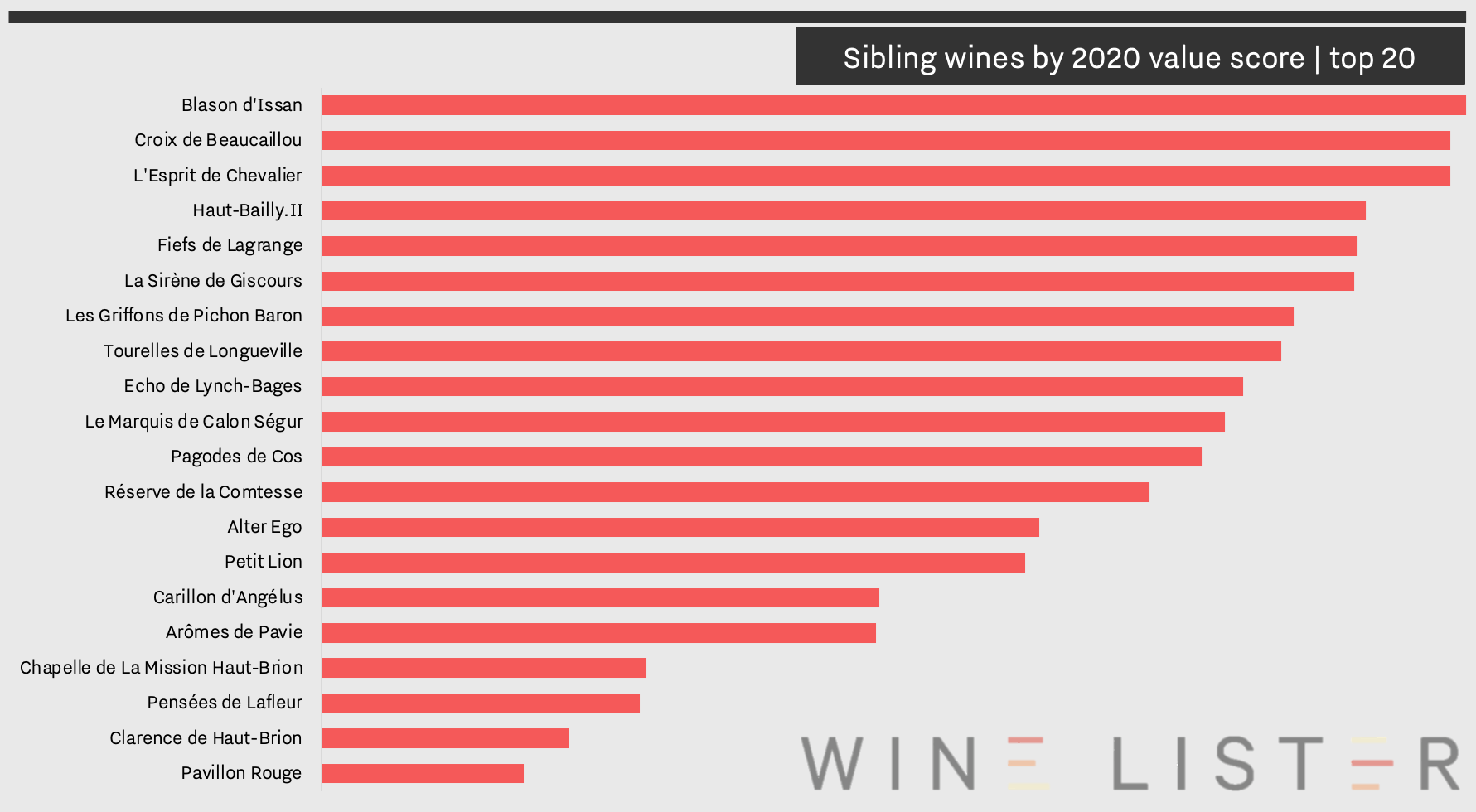 The top 20 leading sibling wines by Wine Lister value score
The top 20 leading sibling wines by Wine Lister value score
Which second wines provide the greatest value?
Often lurking in the shadows of their Grand Vin counterpart, sibling wines offer a high quality, more accessible alternative to Bordeaux’s long-ageing elite. While some are the product of grapes remaining from the Grand Vin, other producers prefer to give a sibling wine its own dedicated plots, often of slightly younger vines. In either case, these wines made at the hands of some of the world’s greatest winemakers should be considered seriously. Below we look at our top picks of sibling wines for value, based on the latest offerings from the Bordeaux 2020 en primeur campaign.
Left Bank legacies
All major Bordeaux appellations across both banks are well-represented amongst the top 20 value picks, with Margaux property, d’Issan achieving the greatest value score for the 2020 vintage. First produced in 1985, Blason d’Issan bears a greater proportion of Merlot than its Grand Vin sibling (57% compared to 39%), but as noted by its maker, Emmanuel Cruse, is still very much a “baby d’Issan”, sporting the château’s perennial style. The second wine of 2020’s wine of the vintage (according to Wine Lister partner critics), Margaux, has been a permanent feature of the estate since the 17th century; christened Pavillon Rogue in 1908, it is 2020’s only top 20 second wine from a First Growth property. Margaux comrade, Giscours, is also represented, by its Sirène de Giscours, which enjoys the same winemaking attention and ageing as the Grand Vin, but with grapes sourced from younger vines. Finally, Margaux majesty, Palmer is featured with Alter Ego. Its 2020 release was well sought-after, particularly after no second wine was produced in 2018.
Pessac-Léognan royalty, Haut-Brion’s Clarence de Haut-Brion ranks among the top 20 sibling wines for value. It is joined by L’Espirit de Chevalier – the red counterpart of Domaine de Chevalier’s sibling series – and Haut-Bailly’s Haut-Bailly II. The latter was renamed (from La Parde de Haut-Bailly) in 2019 to symbolise the second generation of owners, the Wilmers family. Finally, Chapelle de La Mission Haut Brion comes from the same vineyard as the Grand Vin, grown and harvested in the same way, with the introduction of grapes from the older parcels of La Tour Haut-Brion since the 2006 vintage.
Saint-Julien has three properties represented by their second wines, including Croix de Beaucaillou, which ranks in second place. This sibling wine is produced using grapes hailing from its own distinct vineyard, lying to the west of the château. Completing the top five rankings is Fiefs de Lagrange, which bears familiarity to its Grand Vin sibling, but is more suited for earlier drinking. Finally, Léoville Las Cases’ le Petit Lion celebrates its 13th vintage with the release of the 2020, produced from a blend of replanted vines that are now between 15 and 18 years of age.
In neighbouring Saint-Estèphe, Le Marquis de Calon Ségur and Pagodes de Cos occupy 10th and 11th place respectively, with the former taking very different form from their first wine as an alternative interpretation of the Calon terroir. The latter is produced from a separate, dedicated plot of 40-year-old vines.
Completing the Left Bank selection are four Pauillac value picks, of which two hail from the same property. Pichon Baron is the only property to see its two additional wines feature – Les Griffons de Pichon Baron and Tourelles de Longueville. Lynch-Bages’ Echo joins them within the top 10 picks by value score. Finally, Pichon Comtesse’s Réserve de la Comtesse – first sold in 1973 – is a top feature for en primeur 2020. This well-established sibling wine represents between 20% to 50% of Pichon Comtesse’s total production.
Right Bank relatives
One the Right Bank, and particularly in Pomerol, sibling wines have been slower to catch on, simply due to lower production levels per property. Two Saint Emilion Classés A properties nonetheless stand out for sibling value picks– Pavie and Angélus – featuring Arômes de Pavie and Carillon d’Angélus, respectively. The latter is increasingly becoming a “cousin” rather than a sibling, since the property has recently invested heavily in new plots for Carillon alone. Amongst this top pick hoard is Pomerol estate, Pensées de Lafleur, which takes 13th place amongst the top value picks with a limited-production of 500 cases.
Change and adaptation on the banks of Bordeaux
Unpicking the challenges of the 2020 growing season, we talk to seven top Bordeaux producers to understand more about how climate change continues to impact the region’s fine wine industry.
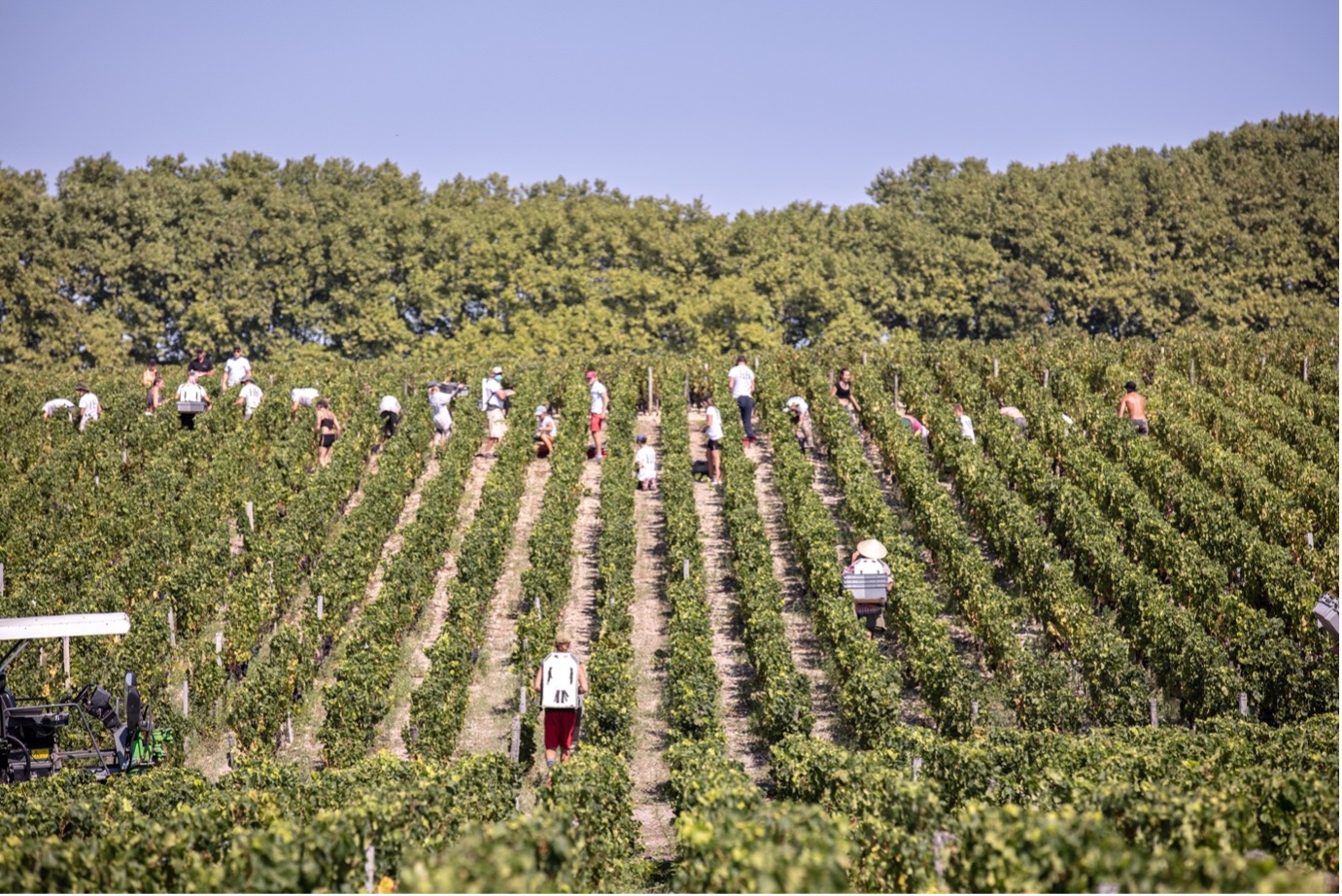 Haut-Bailly harvest under the scorching September sun
Haut-Bailly harvest under the scorching September sun
How is Bordeaux adapting to climate change?
Bordeaux has been no stranger to extreme climatic conditions in recent years, culminating in what some may describe as climatological confusion for many châteaux last year. While witnessing 15% more rainfall between March and September 2020 than its 30-year average for this period, Bordeaux also saw 54 days of excessive drought during the summer. It would appear that now, more than ever, adaptation and innovation are key to the successes of the region’s releases.
Dealing with drought
- Extensive dry spells have become a common phenomenon in Bordeaux, with Margaux’s Business Development Director, Alexis Leven-Mentzelopoulos, sharing with us his concerns that the vines “could end up with wilting” leaves, leading to “a loss in terms of yields but also eventually in terms of quality”. Despite also being one of the wettest years on record, 2020 was no exception with its pattern of heatwaves and ensuing drought.
- Saint-Émilion’s Cheval Blanc experienced its driest vintage since 1959, though Technical Director Pierre-Olivier Clouet explains the humid spring fortunately allowed the vines to accumulate “water and nutrients much needed later in the season”. He elaborates that despite the drought, this allowed vines to “grow calmly and homogenously”.
- Across the Gironde, Haut-Bailly’s Véronique Sanders tells us that “work in the vineyards has evolved enormously”, and that “the fundamental process of pruning has been re-examined” as part of a wider series of viticultural practices that have been changed to adapt to climate change, enabling Haut-Bailly to make the most out of the varied conditions.
Coping with concentration
- Several properties such as Larrivet Haut-Brion saw small and concentrated berries as a result of high temperatures and persistent drought in 2020. The estate’s Cellar Master, Charlotte Mignon tells us that it has had to adapt its winemaking in recent years, opting for punching down versus pumping over in order “to control light and elegant extractions” in such hot years.
- Alexis similarly tells us of Margaux’s recent investment in more highly advanced phenolic analysis equipment, which reports the levels of tannin and pigment in the individually-vinified lots and allows the team to “precisely plan extraction with lower temperatures, fewer and gentler pump-overs, and limited maceration time”.
- Increasingly concentrated grapes have also reduced yields across the region, as told to us by Calon Ségur’s Managing Director, Vincent Millet, whose volumes in 2020 fell to 33hl/ha (down from 40hl/ha in 2019) due to the heat.
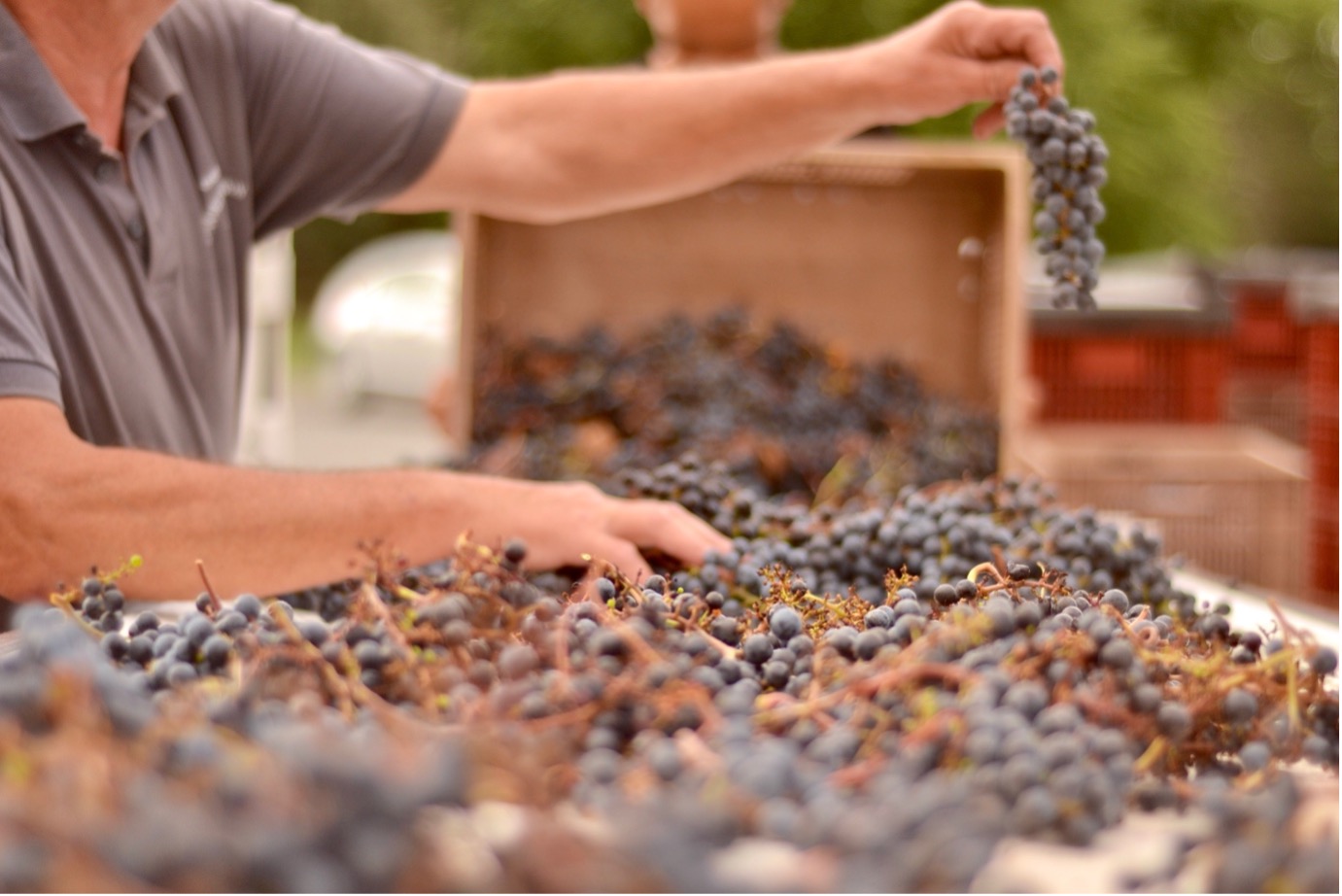 Larrivet Haut-Brion incorporating recently harvested whole bunches into their blend
Larrivet Haut-Brion incorporating recently harvested whole bunches into their blend
A move away from Merlot
- With global warming affecting the evolution of certain grape varieties, Palmer CEO, Thomas Duroux tells us that the “classic complex finish of Merlot” is particularly threatened by rapid ripening induced by hot summers.
- This concern was shared amongst several properties, with Charlotte finding Larrivet Haut-Brion’s Merlot grapes to be heavier, with greater sugar levels and thus a higher alcohol potential. To regain freshness in their Merlot juice, she now “incorporates the whole grape bunch, including the stalk”, to add more structure and tannins. In the long term, the estate is planning to replant more plots to Cabernet Sauvignon due to the varietal’s slower ripening, while Margaux is similarly including “more and more” Cabernet Sauvignon and Cabernet Franc in their blend, and “even thinking of perhaps experimenting with a few rows of Carménère”, to study how it reacts to high temperatures.
- In similar vein, Claire Villars-Lurton of Ferrière remarks on the advantage of less Merlot in the changing climate: “We have prioritised replanting of Cabernet Sauvignon, rather than Merlot, as even young the latter variety is more sensitive to water stress”.
Nourishing nature
- Several of the châteaux we spoke to highlighted their aim of counteracting the effects of climate change by enriching the natural environment and the soil. Thomas emphasises the importance of having a “living soil” in the face of ecological stress, noting that biological compost and plant growth amongst the vines offers “greater stability, root resilience, and nourishment” in increasingly hot and dry years.
- The benefits of a living soil are echoed by Vincent, who tells us that at Calon Ségur they plant grass cover in the vine rows maintains “some moisture in the soil during dry periods”.
- Claire notes that cover crops help to maintain soil biodiversity, but the approach she takes goes beyond this purpose: “we adopt a minimal intervention approach in the vines. We plant cover crops between the rows, that we fold over or cut so as to have a natural mulch – this protects the soil from the damaging effects of strong sunlight, allows the soil to keep a good level of humidity, and means any rain that falls can seep deeper into the subsoils”.
Shading from the sun
- Like several châteaux adapting viticultural practices vintage-by-vintage, Larrivet Haut-Brion withheld leaf removal until later in the 2020 growing season, to shelter grapes from the scorching sun.
- A similar strategy has been adopted at Haut-Bailly, who revise their canopy management every year to reflect the concurrent needs of vines.
- At Calon-Ségur, Vincent explains they are “careful about thinning out the leaves in order to avoid burns”, and are considering “adjusting the height of the trellis” to provide shade from one row to another. Opting for a more permanent solution, Margaux have gone so far as to “change the orientation of the vine rows” in order to “expose each side of the vine to the heat equally and minimize sunscald”.
New additions from this year’s offerings
With the Bordeaux 2020 en primeur campaign now concluded, Wine Lister’s latest MUST BUY update includes 13 new picks from the latest vintage, covering a range of different appellations and price points.
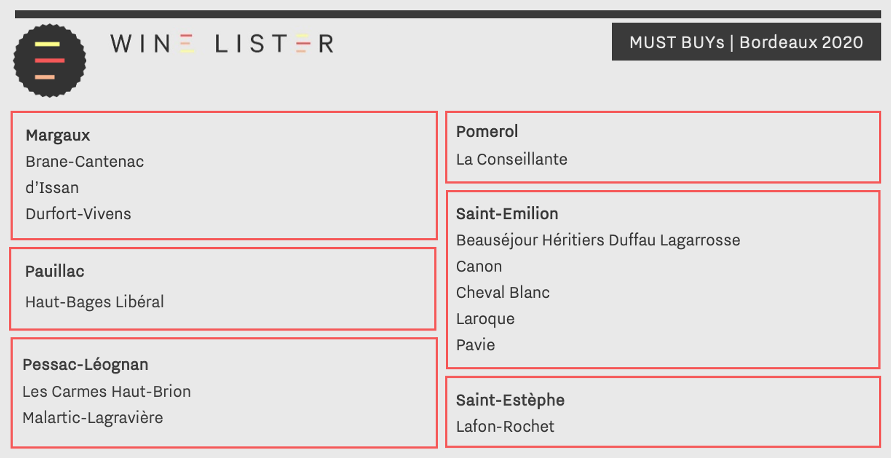 New 13 MUST BUY additions from Bordeaux 2020
New 13 MUST BUY additions from Bordeaux 2020
What are the MUST BUYs from Bordeaux 2020?
Wine Lister’s MUST BUY algorithm takes into account a wine’s quality and value within its vintage and appellation to produce initial recommendations. These results are then filtered through an intelligence-based, human overlay, which identifies MUST BUY wines based on our tasting of Bordeaux 2020, and observation of the reception of each release in the market.
Right Bank insights
Highlighting the success of the Right Bank in 2020, Saint-Emilion houses five of our 13 Bordeaux 2020 MUST BUYs. Amongst the selection is one of Wine Lister partner critic, Antonio Galloni’s (Vinous) “wines of the year”, Pavie 2020, which he scores 97-99, noting “All the elements are well balanced.” The first key release out of the gate this year, Cheval Blanc also gains MUST BUY status. With a score of 96-98 from Neal Martin (Vinous), who calls it “finely proportioned and multi-layered” with a “mineral-driven finish”, the 2020 can be purchased en primeur from Petersham Cellars for £388 per bottle (in-bond).
Beauséjour Héritiers Duffau Lagarrosse, Laroque, and Canon also join the Saint-Emilion entries – the latter gaining praise from Wine Lister CEO, Ella Lister, who describes it as “Full-to-bursting with salivating fruit, just ‘à point’, with impeccable balance”. Canon 2020 can be bought en primeur from £96 per bottle (in-bond) from Honest Grapes.
The Right Bank is represented further by prized Pomerol property, La Conseillante, which retains MUST BUY status for the second vintage in a row. Released at £156 per bottle (in-bond), the 2020 receives a score of 96-98 from Neal Martin, who calls it a “deeply impressive and quite profound La Conseillante”, and is available to purchase en primeur from Goedhuis & Co.
Left Bank investments
Over on the Left Bank, the latest Margaux MUST BUYs comprise 2020s from Brane-Cantenac, d’Issan, and Durfort-Vivens – all of which are available on the market for £50 per bottle (in-bond) or less. d’Issan performs notably well, taking new shape with the introduction of Petit Verdot and Malbec in the latest blend, hailing from new plots purchased by the estate in March 2020. It earns a score of 93-95 from Antonio Galloni, who notes that “Issan is shaping up to be a jewel of a wine.” Appearing in the rankings for most-improved Wine Lister Quality score for a third consecutive year (see our recent blog here), Durfort-Vivens also achieves MUST BUY status in 2020. The estate has seen impressive post-en primeur price performance in recent years, and shows future promise in its upward quality trajectory. Durfort-Vivens’s latest release can be bought en primeur from Justerini & Brooks at £44 per bottle (in-bond).
Pauillac’s Haut-Bages Libéral 2020 receives some of the highest scores ever achieved by the property, including a score of 17 from James Lawther for JancisRobinson.com, who calls it “pure and precise” with “silky and refined” tannins. In neighbouring Saint-Estèphe, Lafon-Rochet also features in the latest MUST BUY haul, with a vintage that marks the inaugural merging of two of the most revered minds in Bordeaux (see our recent blog here). Jean-Claude Berrouet and Eric Boissenot’s joint efforts in 2020 were praised by critics, with Jancis Robinson calling it “a very successful 2020.” Released from £27 per bottle (in-bond), Lafon-Rochet 2020 also gains Value Pick status, and can be purchased at Jeroboams.
Pessac-Léognan provides two MUST BUYs in 2020, with Malartic-Lagravière receiving a score of 93-95 from Antonio Galloni, who describes it as having “An extra kick of energy and vibrancy that is quite attractive”. Les Carmes Haut-Brion 2020 earns 95-97+ from the critic, and can be acquired from Jeroboams for £79 per bottle (in-bond).
Explore all Wine Lister MUST BUYs here, or discover more Bordeaux 2020s here.
Bordeaux en primeur 2020 saw mixed pricing decisions throughout the campaign. To help those still looking to purchase en primeur this year, we examine some of the best offerings from the latest vintage at five different price points. (All prices are quoted in-bond per bottle when purchasing by the case).
Click here to view all Bordeaux 2020 releases, or read more below.
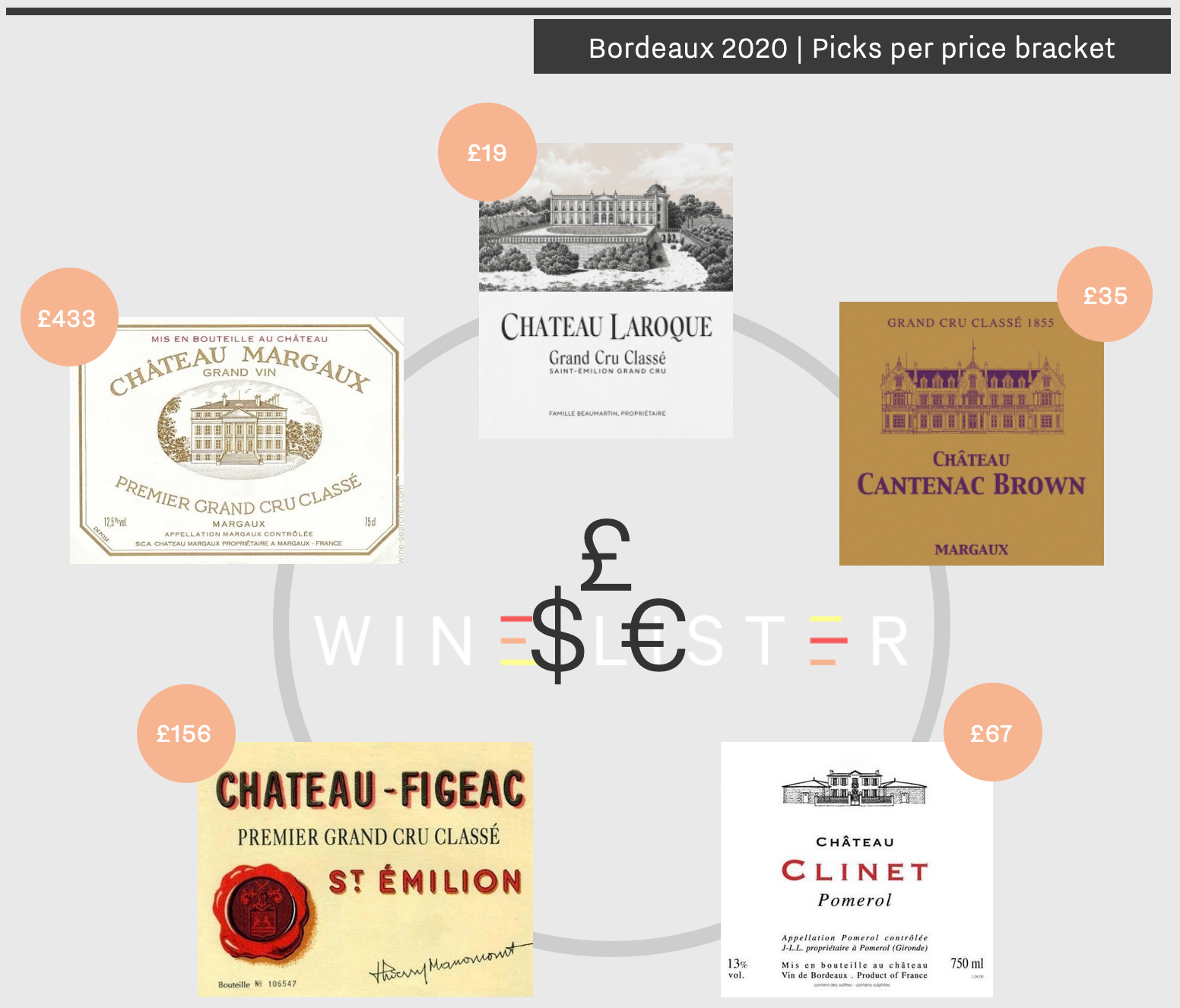
Under £20 – Laroque
Attesting to the estate’s sustained step-up in quality since its 2018 vintage, Laroque receives strong critical praise in 2020. Antonio Galloni and Neal Martin (Vinous) both award 93-95, with the latter calling it, “Possibly the best Laroque that winemaker Suire has overseen to date.” Having worked at fellow Saint-Émilion estates, Bellevue, Beauséjour Héritiers Duffau Lagarrosse, and Larcis Ducasse over the past 15 years, winemaker David Suire joined Laroque in 2015. He has since invested in making significant quality improvements, changing the winemaking process of the Grand Vin to now consist solely of free-run juice and no press wine. The third Laroque release in a row to achieve Value Pick status, the 2020 vintage can be bought from Justerini & Brooks for £18.92 per bottle (in-bond).
Under £50 – Cantenac Brown
The recent acquisition of Margaux Third Growth, Cantenac Brown, by agro-engineer, Tristan Le Lous, brought about a buzz of excitement for his first full vintage at the estate. Under its new ownership, the estate has expanded its vineyards by 9.5ha to incorporate high-quality vines from neighbouring estates, La Galiane and Charmant on the iconic Margaux plateau. Efforts to improve their blend, through the introduction of 70% of the grapes harvested on these new parcels, are reflected in top scores for the 2020 vintage, which receives its highest ever score from Antonio Galloni (94-97). Tasted by Wine Lister CEO, Ella Lister, she calls it, “A very successful Cantenac Brown.” Cantenac Brown 2020 can be purchased en primeur from Goedhuis for £34.33 per bottle (in-bond).
Under £100 – Clinet
Pomerol’s rising star, Clinet once again provides good value within its appellation in 2020. With traces of the vineyard dating back to 1595, one of Pomerol’s oldest estates is managed under the watchful eyes of a small team, co-headed by President of the UGCB, Ronan Laborde. Receiving a score of 94-96 from Neal Martin, he notes, “This is a Pomerol that really wants to make an impression.” Ella found the 2020 vintage to be, “Seamless and languorous. A triumph.” Clinet 2020 is available en primeur at IG Wines for £66.50 per bottle (in-bond).
Under £200 – Figeac
Completing a trilogy of top-scoring vintages, Figeac 2020 highlights the estate’s skilled adaptation to the extreme climate conditions it faced in the year. The team recently reflected on the challenges brought about by “mild winter temperatures, summer heat-waves, and unusually variable rainfall” in 2020, which nonetheless produced one of Ella’s favourite wines from the vintage. Tasting in Bordeaux, she notes a “Trademark Figeac texture. The harmony is mind-blowing.” This Saint-Émilion star can be purchased en primeur from Farr Vinters for £156 per bottle (in-bond).
Over £300 – Margaux
Margaux is one of Wine Lister’s top picks at the premium end of the en primeur spectrum. The highest-scoring wine of the vintage, Margaux is the only 2020 to receive a WL score of 98 (an average combining all Wine Lister’s partner critics on a 100-point scale). According to the Margaux team, the success of the vintage is down to the amalgamation of “homogenous flowering, summer conditions that favoured small berries, and excellent harvesting conditions.” Indeed, the 2020 receives a score of 19 from James Lawther for JancisRobinson.com, who describes it as the “Perfect pitch”, while Ella was “Wowed”, stating “This will age into eternity, and yet the texture is already soft now.” For those looking to find this First Growth, Margaux 2020 can be reserved for £433 per bottle (in-bond) via Petersham Nurseries.
As the Bordeaux en primeur campaign draws to a close, Wine Lister has published its latest Wine Leagues on the new vintage – exploring which Bordeaux 2020s rank best for WL score in each major appellation (as separated by decimals).
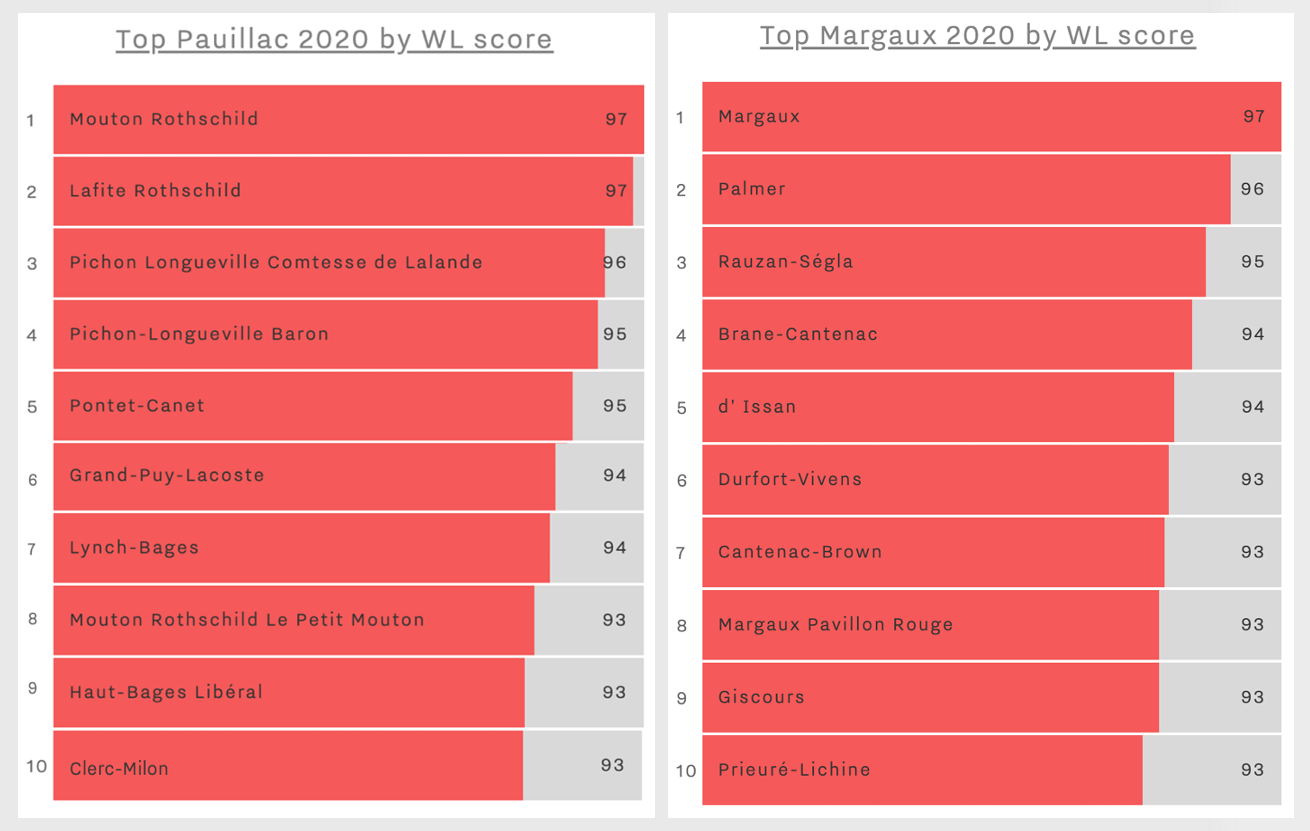
For the third year running, First Growths Mouton and Lafite dominate the Pauillac leader board with a joint WL score of 97. Super-seconds Pichon Comtesse and Pichon Baron follow suit with scores of 96 and 95, while Haut-Bages Libéral has climbed to joint-eighth place in 2020 (from ranking 18th in 2019). As explored in Part II of Wine Lister’s Bordeaux study, the estate is one of the top-15 wines to have seen its quality improve the most in 2020, compared to its average Quality score (explore key findings from the study here).
The Margaux appellation possesses the top-scoring wine of the vintage, Margaux 2020. Wine Lister CEO, Ella Lister, tasted the vintage and is confident that “This will age into eternity. And yet the texture is already so soft now.” For the second year in a row, Palmer secures the next-best place with a WL score of 96, while Rauzan-Ségla climbs eight places this year, into the third spot.
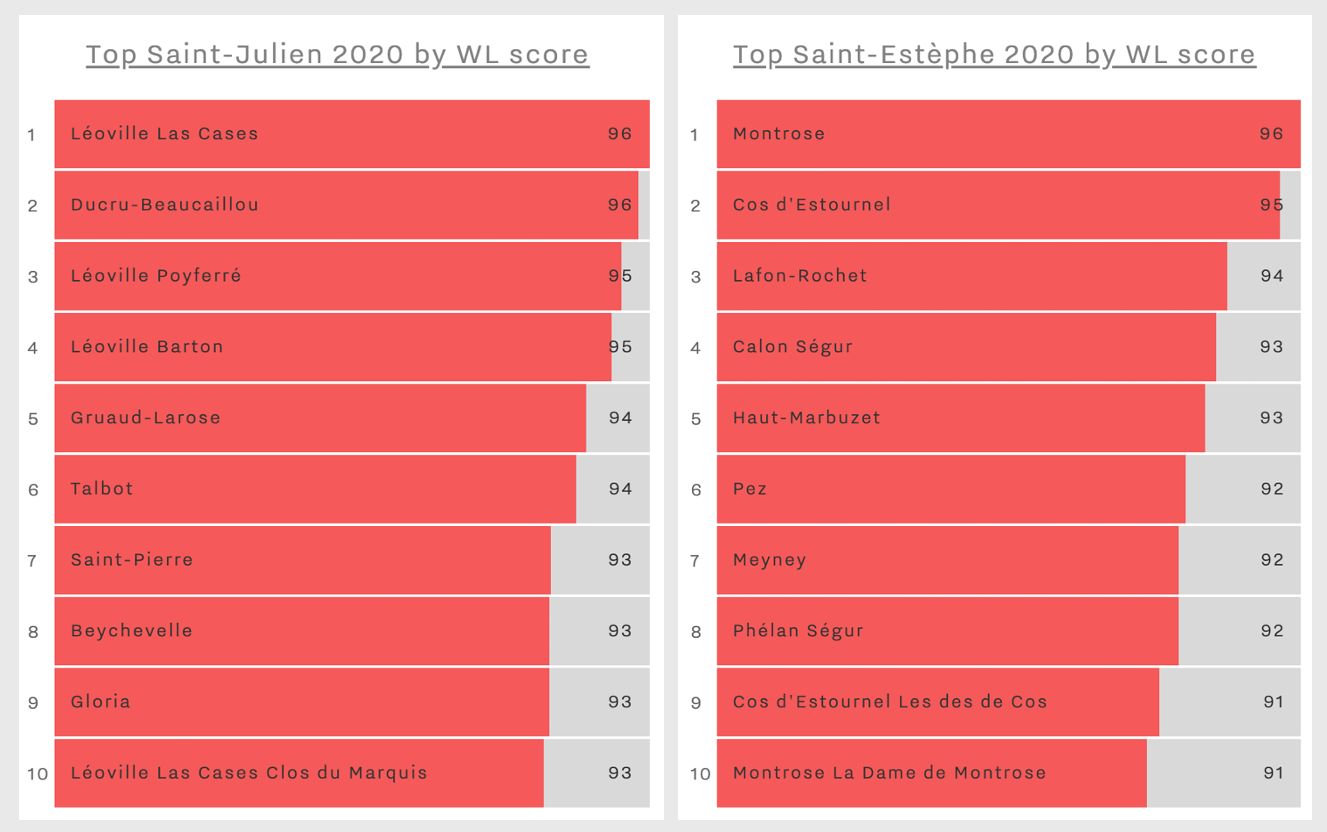
The top five Saint-Julien 2020s are in line with that of last year’s league, with Léoville Las Cases and Ducru-Beaucaillou sharing the top WL score of 96. Neighbours Léoville Poyferré and Léoville Barton follow suit with 95, while Gruaud-Larose once again achieves fifth place. Also appearing on the list of top 15 wines whose perceived quality in 2020 most exceeded their average, (Part II of Wine Lister’s Bordeaux Study) Talbot climbs four places since last year’s league, securing a WL score of 94 for the first time since its 1986 vintage.
Wine Lister Buzz Brand, Montrose, has another successful vintage in 2020, overtaking last year’s leader, Cos d’Estournel, to achieve the top place in the Saint-Estèphe league. Tasting in Bordeaux, Ella describes Montrose as having “silkiness in spades” and “beautifully integrated” wood on the palate. Lafon-Rochet climbs four spots to third place in 2020, having gained its highest WL score since 2016 (94). Entering the market last month (Thursday 20th May), the estate also features alongside Haut-Bages Libéral and Talbot as one of Wine Lister’s Quality score outperformers for the vintage.
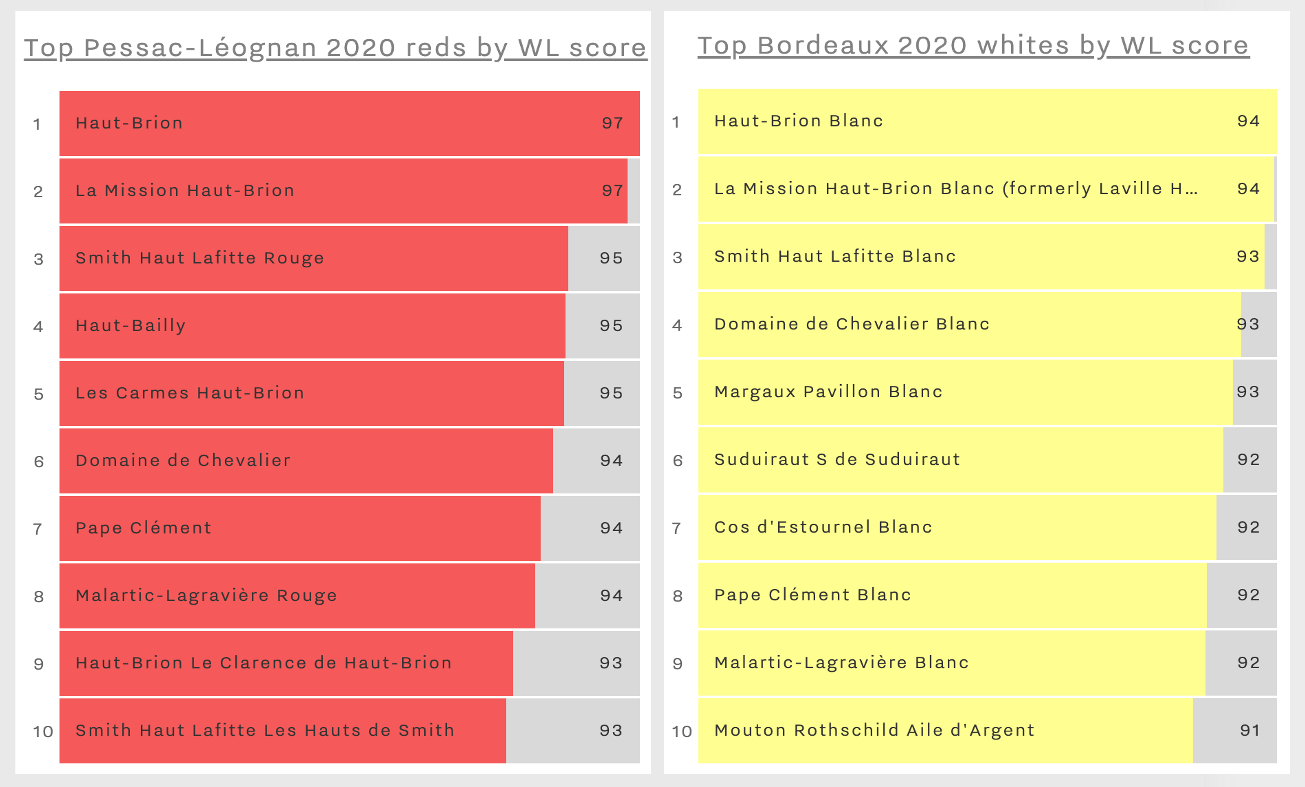
Haut-Brion and La Mission Haut-Brion perform notably well, once again achieving joint-first place in the league of top Pessac-Léognan 2020 reds. As in 2019, Smith Haut Lafitte and Haut-Bailly share third place, alongside the en primeur darling, Les Carmes Haut-Brion, whose WL score increases by one mark this year to 95. Second wines Les Hauts de Smith and Le Clarence de Haut-Brion enter the league with WL scores of 93, with the former gaining with its highest ever WL score in 2020.
Despite both scoring slightly down from 95 in 2019, Haut-Brion and La Mission Haut-Brion attain joint-first place for their whites as well as reds in 2020, achieving scores of 94 in the league of top Bordeaux whites by WL score. Tasting Haut-Brion Blanc, Ella notes it “Flexes its flinty muscles on the nose, with an almost Burgundian minerality accompanying its unmistakable Pessac green and yellow-fruit character.”
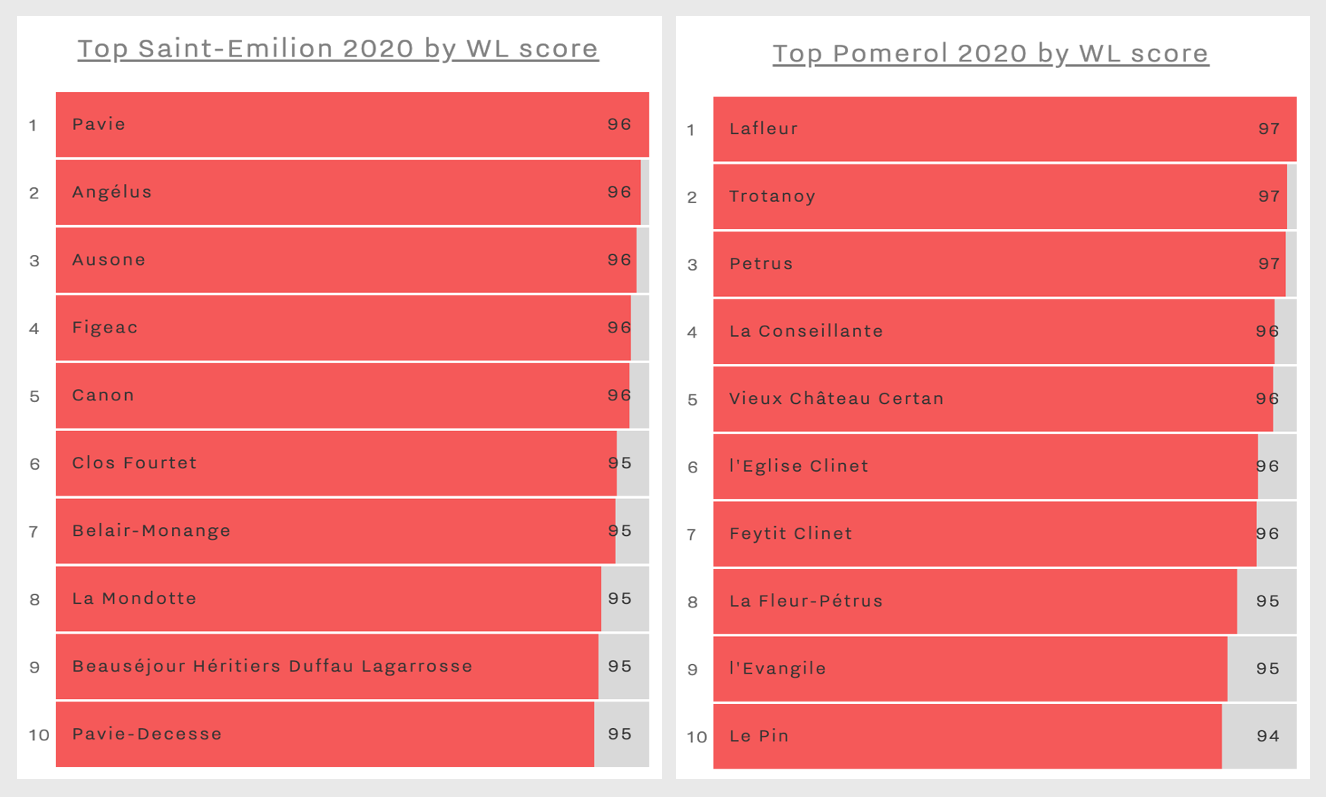
Pavie rises through the ranks from fourth place last year to lead Saint-Emilion’s league for the 2020 vintage, alongside Angélus, Ausone, Figeac, and Canon, whose scores of 96 are separated by fractional differences. Having been awarded 97-99 by Wine Lister partner critic, Antonio Galloni (Vinous), he describes it as, “Very clearly one of the wines of the year.” Clos Fourtet has climbed significantly this year, now standing in sixth position (up from the 17th spot in 2019).
As the only appellation to achieve a significantly higher average Quality score in 2020 than in 2019 (as explored in Part II of our Bordeaux Study), Pomerol takes the top spot for Quality score across all appellations in the latest vintage. Lafleur, Trotanoy, and Petrus share the leading WL score in its 2020 league (97), beating their score of 96 last year. Lafleur 2020 receives notable praise from the few critics who tasted in Bordeaux – Ella describes its mouthfeel simply as “out of this world”.
Click here to view all Wine Leagues. Pro users have access to a more extensive set of Leagues and can log in to access here.
 Seña and Chadwick owner, Eduardo Chadwick, and daughter, Magui
Seña and Chadwick owner, Eduardo Chadwick, and daughter, Magui  Tasting Vin de Constance 2018 alongside Klein Constantia Winemaker, Matt Day
Tasting Vin de Constance 2018 alongside Klein Constantia Winemaker, Matt Day  From left to right: Lupo Theones, Victor Petiot, Gareth Ferreira, Beatrice Bessi, and Paul Lo
From left to right: Lupo Theones, Victor Petiot, Gareth Ferreira, Beatrice Bessi, and Paul Lo  From left to right: Stefan Kobald, Victoria O’Bryan, Julien Sarrasin, Jonathan Charnay, and Pascaline Lepeltier
From left to right: Stefan Kobald, Victoria O’Bryan, Julien Sarrasin, Jonathan Charnay, and Pascaline Lepeltier The top 20 leading sibling wines by Wine Lister value score
The top 20 leading sibling wines by Wine Lister value score






